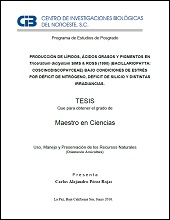Producción de lípidos, ácidos grasos y pigmentos en Triceratium dictyotum Sims and Ross (1990) (Bacillariophyta: coscinodiscophyceae) bajo condiciones de estrés por déficit de nitrógeno, déficit de silicio y distintas irradiancias
Abstract
La diatomea Triceratium dictyotum tiene un buen potencial para la producción de ácidos grasos poliinsaturados (PUFA) y fucoxantina, pigmento carotenoide con gran potencial antioxidante, y es nativa del Golfo de California por lo que está adaptada a los factores abióticos y bióticos regionales predominantes, favoreciendo su uso para la producción local. Diversas especies de microalgas responden a un estrés por déficit nutricional mediante la producción de lípidos y de pigmentos, sin embargo, estos efectos no se ha estudiado en T. dictyotum. Con el objetivo de evaluar el efecto del estrés nutricional sobre el crecimiento, contenido de lípidos, ácidos grasos y fucoxantina; T. dictyotum fue cultivada y sometida a estrés por déficit de silicatos y nitratos, en irradiancias de 20, 70 y 120 µmol·m-2·s-1 en un sistema de dos etapas para generar biomasa en la primera y observar el efecto del estrés en la segunda. Para determinar que los tratamientos con distintas cantidades de nutrientes se aplicaron correctamente se midió la concentración de nitratos y silicatos. El efecto del estrés fue evaluado mediante la densidad celular, el contenido de lípidos totales, de ácidos grasos y de pigmentos fotosintéticos. El estrés por déficit de nitratos no fue adecuado para la producción de los PUFA AA, EPA, DHA ni fucoxantina resultando en productividades máximas de 0.03, 0.04, 0.002 y 0.02 mg·L-1·d-1 respectivamente; el déficit de silicatos combinado con alta o baja irradiancia induce la producción de ácidos grasos y, solamente con baja irradiancia, la producción de pigmentos, sin embargo, la productividad disminuye debido la tasa de crecimiento baja, obteniendo valores máximos de 0.09, 0.4 y 0.029 mg·L-1·d-1 de AA, EPA y DHA en alta irradiancia y 0.21 mg·L-1·d-1 de fucoxantina en baja irradiancia; por otro lado, los cultivos sin estrés nutricional y con irradiancia media alcanzaron valores de productividad de 0.28, 0.71, 0.046 y 0.21 mg·L-1·d-1 para AA, EPA, DHA y fucoxantina respectivamente, con estas condiciones no se limita el crecimiento de la microalga, permitiendo alcanzar la productividad más alta de PUFA y pigmentos. The diatom Triceratium dictyotum is native to the Gulf of California and adapted to regional abiotic and biotic factors, favoring its for local production because of its potential for production of polyunsaturated fatty acids (PUFA) and fucoxanthin, a carotenoid pigment with great antioxidant potential. Several species of microalgae respond to stress by nutritional deficiency producing lipids and pigments; however, it has not been studied in T. dictyotum. The effect of nutritional stress was evaluated on growth, content of lipids, fatty acids, and fucoxanthin. T. dictyotum was cultured and exposed to silicate and nitrogen starvation stress with irradiance of 20, 70, and 120 µmol·m-2·s-1 in a two-step system to generate biomass in the first one and observe the effect of stress on the second one. The concentration of nitrates and silicates was measured to assess the nutritional deficit. The effect of stress was evaluated using cell density, total lipid content, fatty acids and photosynthetic pigments. Nitrate deficit stress was not appropriate for the production of PUFA AA, EPA, DHA nor fucoxanthin resulting maximum productivities of 0.03, 0.04, 0.002, and 0.02 mg·L-1·d-1, respectively. Silicate deficit combined with high or low irradiance induces the production of fatty acids and only with low irradiance, pigment production. However, productivity decreased because growth rate was lower than without stress, obtaining maximum values of 0.09, 0.4, and 0.029 mg·L-1·d-1 for AA, EPA, and DHA in high irradiance and 0.21 mg·L-1·d-1 for fucoxanthin in low irradiance. On the other hand, crops without nutritional stress and average irradiance reached productivity values of 0.28, 0.71, 0.046, and 0.21 mg·L-1·d-1 for AA, EPA, DHA, and fucoxanthin, respectively; these conditions did not limit growth in microalgae, reaching higher productivity for PUFA and pigments.
Collections
Related items
Showing items related by title, author, creator and subject.
-
PROMOCIÓN DEL PERIFITON PARA EL CULTIVO DE CAMARÓN BLANCO: HACIA UNA ACUICULTURA ECOLÓGICA
DOMENICO VOLTOLINA LOBINA; JUAN MANUEL AUDELO NARANJO; MARIA DEL ROSARIO PACHECO MARGES -
Suelo y Erosión
YOLANDA LOURDES MAYA DELGADO


